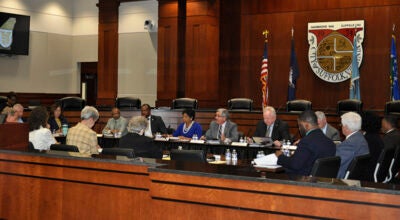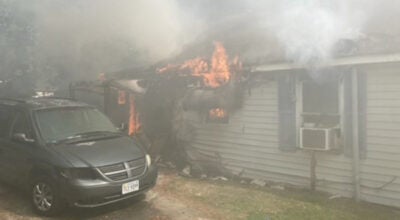A lengthy cleanup
Published 5:29 pm Saturday, April 11, 2015
TCC decontamination project continues to expand
Twenty-eight years ago this month, Virginia State Police became aware of the presence of dynamite at the Tidewater Community College campus in North Suffolk.
The U.S. Army sent an explosive ordinance disposal team to the former Department of Defense site. Buried about 18 inches, technicians found an old ammunition box containing debris, and some crystalline pieces of TNT.
Federal and state officials discussed the discoveries on the telephone, and at first, “(n)one of these conversations conveyed a sense of urgency about the site,” according to government records.
But by the 23rd of that month, authorities found an area “about the size of two football fields” that warranted a closer look. “They found at least one unexploded round, crystalline TNT, and evidence of chemical contamination.”
Officials decided the 975-acre Former Nansemond Ordnance Depot would have to be decontaminated. 28 years later, that work is incomplete, and there is much to be done to make the site safe for development.
The location’s military history began during the Civil War, when Confederates positioned artillery at “Pig Point” to protect the mouth of the Nansemond.
In the world wars that came after, ordnance was shipped from the site at the end of College Drive and it was received there after hostilities ended.
In 1960, after it was declared surplus to defense requirements, the site was deactivated and given to a charitable foundation to become a boys’ military school.
Later, most of it was deeded to the commonwealth, with the stipulation that it would continue to be used for education, and the TCC campus was built.
After relocating that campus to Portsmouth, TCC is now considering a mixed-use development plan for the waterfront property. That’s based on work by the Urban Land Institute, which college and city of Suffolk officials — who are working on a separate, smaller project — hired about four years ago to explore options.
The college created the Tidewater Community College Real Estate Foundation to advance the project, which in turn hired Sorrentino Consulting to help.
William Sorrentino, the firm’s president and CEO, has recently gone on the offensive about the delays in completing the decontamination.
“It appears to me that what we have here is a lollipop that never ends — it’s going to be around for a long time,” Sorrentino said during a telephone interview last week.
Based on investigations, testing and contamination removal at the site during the remainder of the 1980s and most of the next decade, the Environmental Protection Agency added the site to its National Priority List in 1999.
The cleanup, managed by the Corps, has been advised by a board whose 17 members in February received copies of a pointed letter Sorrentino wrote to Sher Zaman, who oversees the project for the Corps.
Sorrentino pointed out several alleged inconsistencies with the draft 2015 site management plan. His overall concern was the consistent growth in the Corps’ schedule to complete the restoration.
Between 2007 and the 2015 draft, the schedule in the annual plans has increased by 12 years, Sorrentino noted.
During an interview, Sorrentino said the project suffers from “a lack of schedule management.”
“We need to move this thing along or, in my view, it will never be done,” he said.
At the North Suffolk Library, where the project records are held, the earliest site management plan is from 2002 and projects Corps involvement in the site through 2006. The latest draft plan indicates the Corps will remain involved through 2025.
Zaman says there’s a good reason for the growing schedule. He describes the cleanup in terms of a voyage of discovery. Every time an area of concern is probed, the schedule can grow.
“When you look at a project … such as a building, you already have all the parameters that you need,” he said. “When you look at an environmental project, you are looking at a blank slate. You have no idea what the contamination is.”
An example in the 2015 draft plan is the James River beachfront, among about 20 sites within project yet to be closed out.
After almost a decade of work beside the southern terminus of the Monitor Merrimac Memorial Bridge-Tunnel, the ecological risks were declared negligible in 2005. But a subsequent investigation found the potential for more munitions and explosives, and the site is now eligible for delisting in 2021.
Nearly $60 million has been spent cleaning up the site so far, and the total could increase to nearly $100 million before the job is done, Zaman said.
Of the five or six former defense sites on the EPA’s national priority list, the North Suffolk cleanup is the only one currently active, Zaman said.
“We have been getting all the money that we have been asking for,” he said. “More money doesn’t mean it will be finished more quickly.”
According to Sorrentino, “Federal tax dollars are being put into a project, and you are not seeing a result. Taxpayers should be incensed over this.”
Advisory board member Cherie C. Walton, who owns a company with her husband in hazardous material remediation, disagrees with Sorrentino. “There’s nothing nefarious going on; it’s just the nature of the beast,” she said. “The schedule is not ballooning out of control.”
TCC Executive Vice President Frank Dunn, who serves as the foundation’s executive director, sought to distance himself from the consultant’s remarks. The foundation is working with the Corps to improve the cleanup schedule, he said, and the schedule “is driven by factors that we don’t control.”
Zaman said the cleanup could be completed sooner if the Corps knew the plans for the site. For instance, a future asphalt parking lot requires less remediation than a future backyard where children will play.
“When we don’t know what they are doing, we can only assume we need to do something more — for example, clean up to residential level,” Zaman said.
Dunn said the foundation is taking a deliberate, conservative approach to developing plans for the site. The ULI study concluded it would be “some time before developing that property would be appropriate,” he said.
Dunn also said he is sure the growth in the cleanup schedule since the early 2000s is “disappointing to a lot of folks, and not just the foundation and not just the members of the (advisory board) or the Corps project management themselves or the regulatory agencies.”
“We have a good working relationship with the Corps,” he said. “We intend to maintain that good working relationship.”






